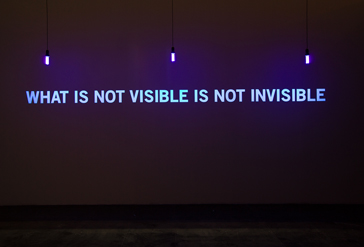
Born in 1978 in Épernay (FR)
Lives and works in Paris (FR)

2008
Installation, invisible ink, ultraviolet light bulb.
Dimensions variables
Year of Purchase: 2007
Julien Discrit’s What is not visible is not invisible exists in two stages which correspond to two states of the work. In the first, the infrared lamp is turned off and the lettering (in invisible ink) cannot be seen. In the second, the lamp is on and the phrase “What is not visible is not invisible” appears.
If J. Discrit’s work draws heavily on conceptual art statements—the enunciations written on or pasted onto the walls of exhibition spaces—the artist goes beyond the quest for formal neutrality of the 1970s’ conceptualists by introducing a visual and temporal phenomenon into his installation. The statements were, among others, part of the polemic against “retinal” art. However, the best conceptual artists very quickly understood that their concepts were enriched by our perception and that neutral form was a fiction. Even the most banal typography has a history and a form which charge it with meaning.
From 1969, Stephen Kaltenbach has exemplified this awareness in a paradoxical way with his Art Works. Taking the form of a commemorative plate, Art Works seems to indicate that the work of art is dead but at the same time declares that art “works.” With the visual disposition of a text, S. Kaltenbach recognizes that our eyes are more than mere “channels” through which written formulations of concepts pass before entering our heads. J. Discrit’s work is conceptually purer and more theatrical than Kaltenbach’s, but in both cases the interplay between the visual formatting of the text and its meaning is key. In Discrit’s work, the light is triggered by the viewer’s entrance. Unlike a statement which is static and perfectly exemplifies Lessing’s axiom about visual arts as spatial arts, What is not visible is not invisible clearly reveals at once time and space.
If the procedure is simple and does not differ from the one used in chapels (the lights which illuminate the paintings are automatically switched on by the approach of the visitor), nevertheless, there is an essential difference: in the chapels, the lights are a necessary condition for the perception of the works. In other words: the work appears only when the light is on. In J. Discrit, the work emerges out of the consecutive perception of the two states (lamp on/lamp off). Contrary to what one might think, the work is not the lettering on the wall, or even “the lettering + the light.” The work exists in the transition from one to the other. It demonstrates visually what it affirms verbally.
By creating an apparent visual paradox, the artist underscores this common confusion between the visible and the non-visible: if what is not visible is not invisible, it’s that it may be non-visible to a given person at an instant t.
Klaus Speidel